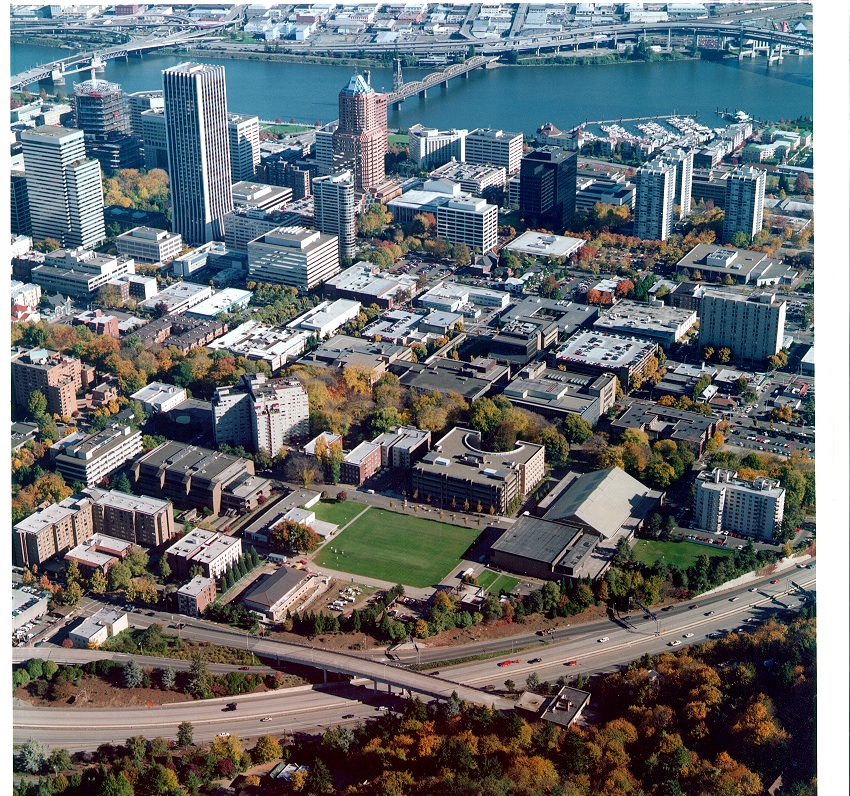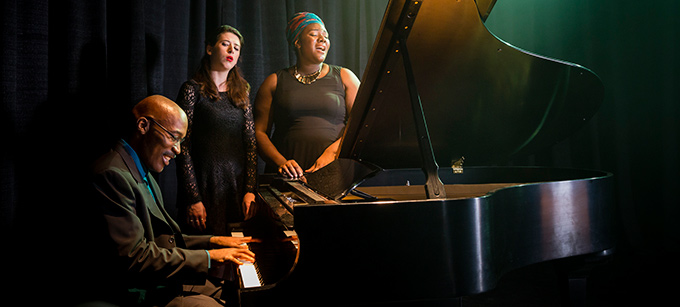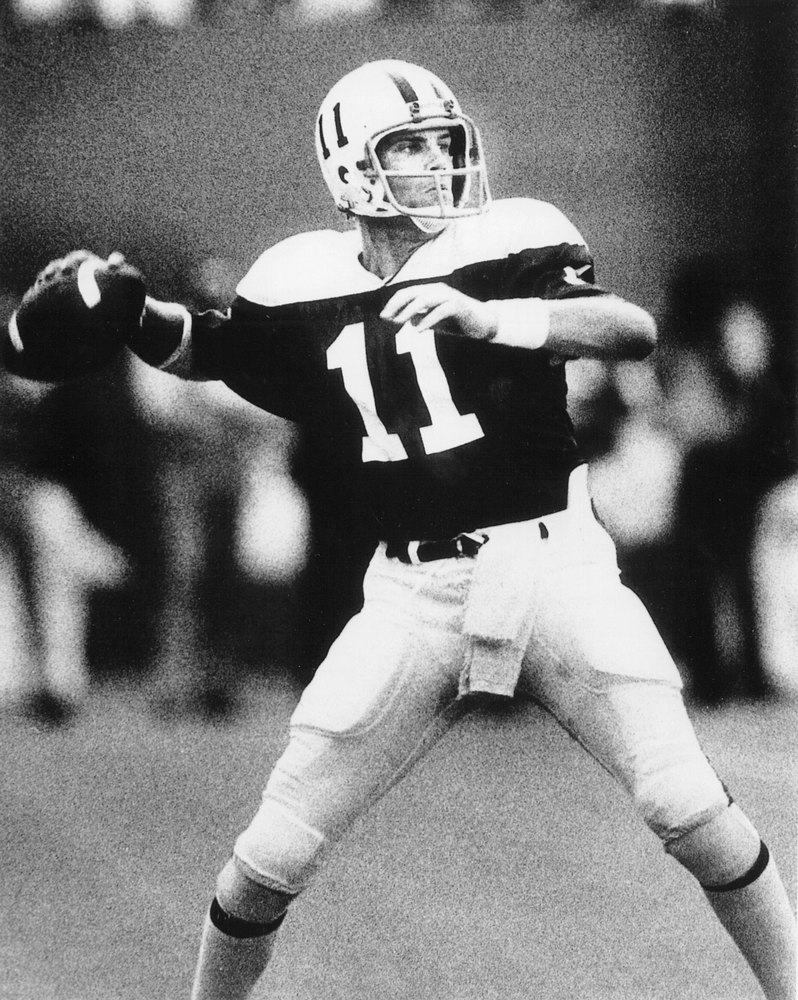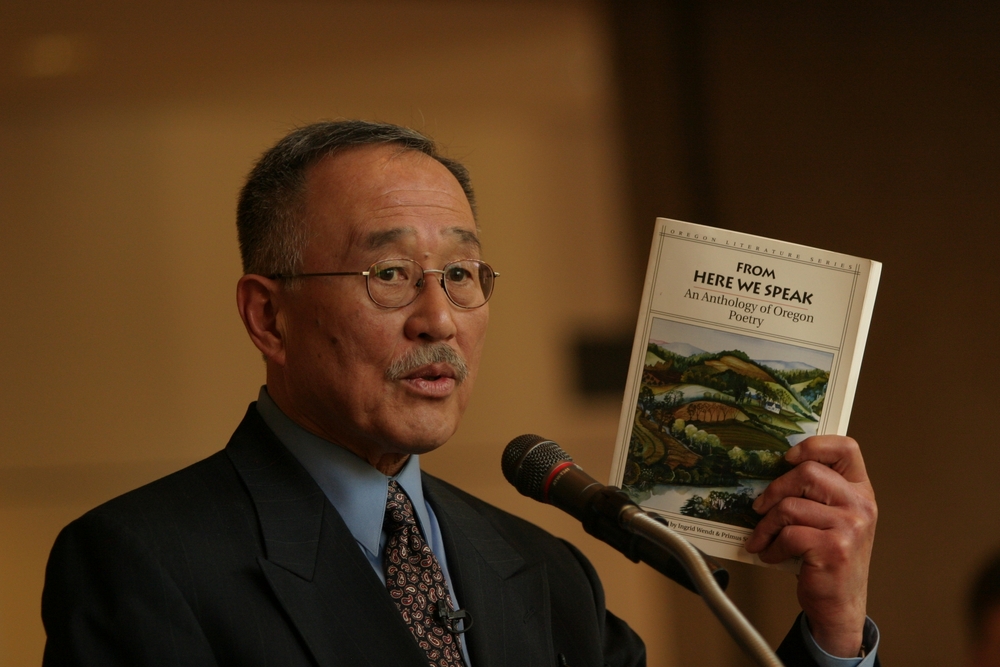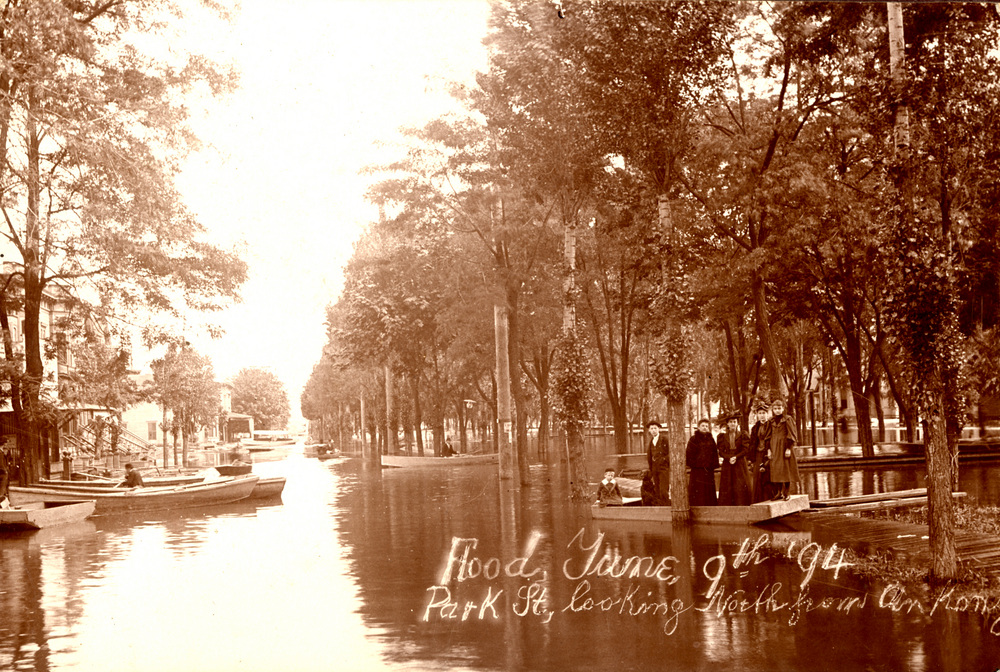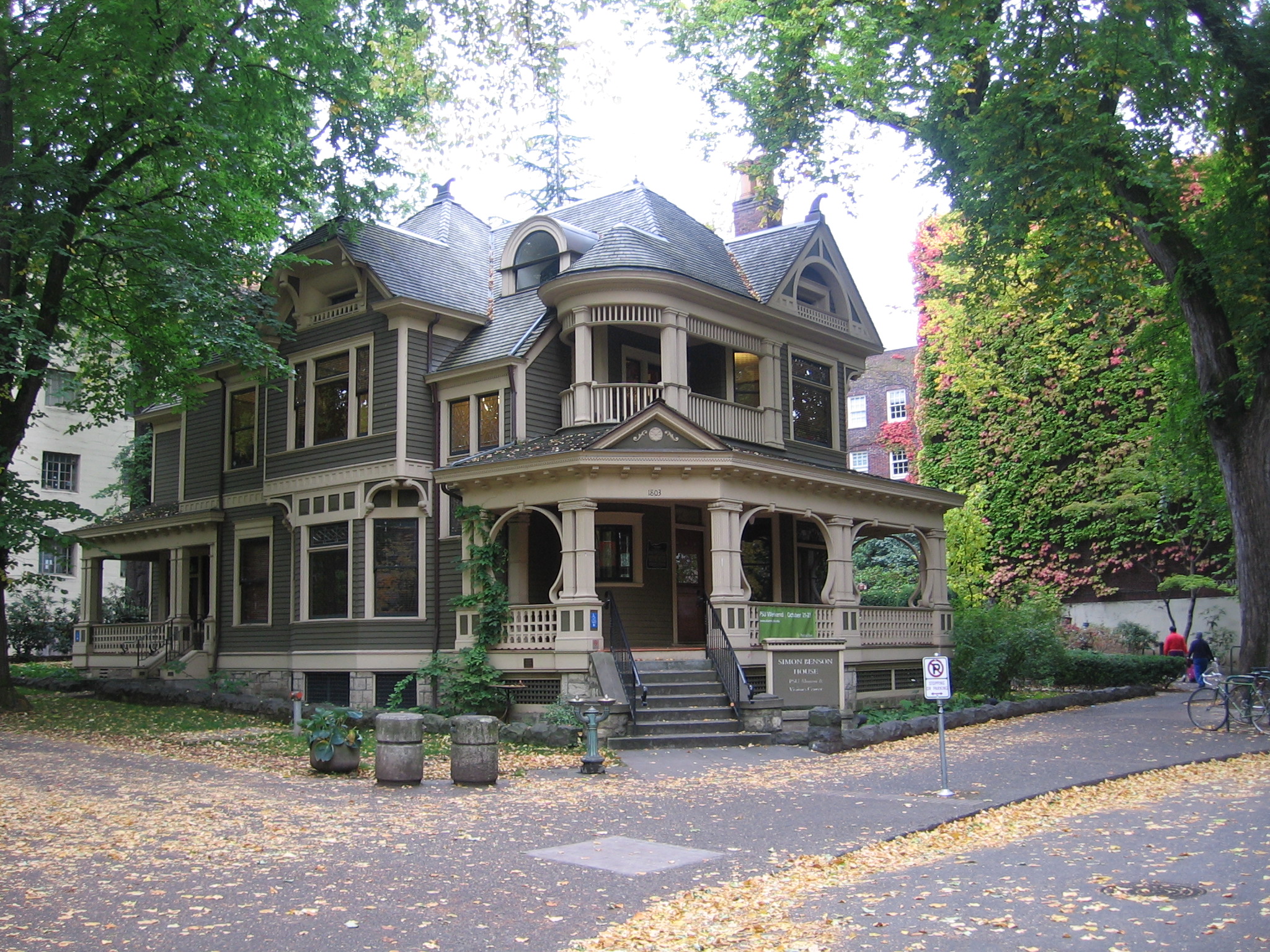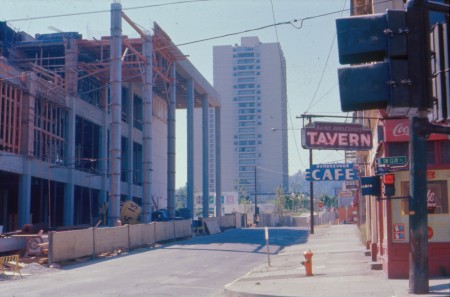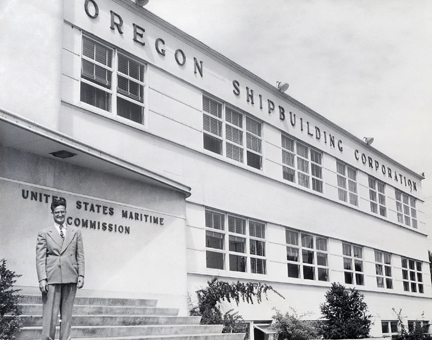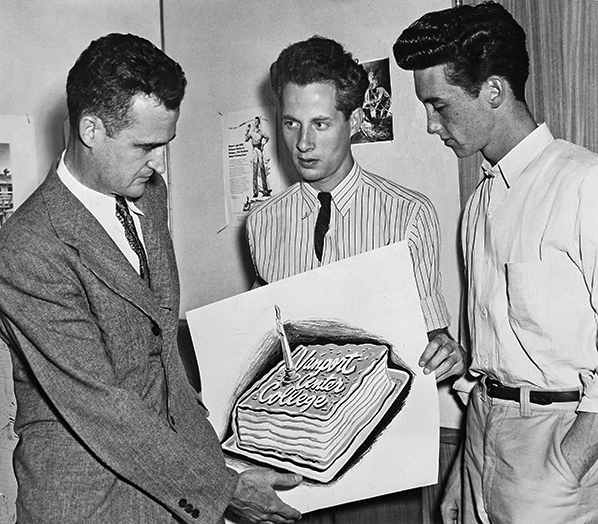Located in downtown Portland, Portland State University is Oregon’s urban research university. One of the two largest universities in the state, it is also the most ethnically diverse. From its beginnings as a temporary extension center after World War II, Portland State has become a metropolitan university that offers more than 120 graduate degree programs and a nationally recognized model of innovative undergraduate education to nearly 30,000 students from all 50 states and 84 countries.
The Vanport Extension Center opened in 1946 as a temporary educational institution of the Oregon State System of Higher Education, offering the first two years of college to 1,400 World War II veterans. Initially located in the City of Vanport, north of Portland, the center was so popular that in 1952, under Director Stephen Epler, it became a permanent, two-year institution with a new home in the old Lincoln High School on Portland’s South Park Blocks. On February 6, 1952, John Francis Cramer, dean of the General Extension Division and future Portland State president, informed Epler that the OSSHE had authorized a new name, the Portland State Extension Center.
Epler and his supporters began working on expanding the center into a four-year, degree-granting institution. In April 1953, the Oregon legislature approved HB 713, which allowed the center to offer four-year programs but withheld the authority to grant degrees. The school finally became a degree-granting institution on February 14, 1955, and was renamed Portland State College. The legislature established its boundaries as Market Street to the north, Hall to the south, Broadway to the east, and Park to the west. It envisioned Portland State as a “downtown city college…not of the campus type,” precluding the availability of student housing. By 1961, the student body had swelled to over 4,500 students, and the campus included two new classroom buildings, a library, a student union center, and another five pre-existing buildings repurposed as classrooms and offices.
In the fall of 1962, under the leadership of President Branford Millar (1959-1968), social work became the first master’s-level graduate degree offered at the college. A graduate program in education was authorized in 1958 but remained unfunded until its first class in September 1963. An additional eight master’s degrees in liberal arts and sciences were available in 1965 to the college’s 8,700 students. Portland State students made national headlines in 1965 after its College Bowl quiz show team went undefeated and broke scoring records against more prominent institutions.
In 1964, the Portland Development Commission designated nearly all of the property south along the Stadium Freeway (I-405), west to Southwest 13th Avenue, and east to Southwest 6th Avenue as an Urban Renewal zone available for Portland State development. Following federal Housing and Urban Development approval in 1965, the college began acquiring land and clearing nonacademic structures within its new boundaries.
Portland State’s first doctoral programs launched in 1968. Due to a longstanding OSSHE policy of not duplicating doctoral degrees among the state’s public universities, Portland State’s degrees focused on interdisciplinary education. Inaugural doctoral programs in urban planning and environmental sciences began 1969-1970, with a program in systems science following the next year. On February 14, 1969, the college was renamed Portland State University. By then, the university had acquired 40.4 acres within the 1965 boundaries but lacked funding for new construction. Taking advantage of this, Portland Student Services (now College Housing Northwest) acquired the use of nine vacated apartment buildings, bringing student housing to campus. As academic programming expanded so did the campus infrastructure, and between 1966-1972 original construction projects added a physical education building, two science buildings, a new library, two classroom building additions, a facilities and services building, and a daycare center. In 1972, a project was begun in the South Park Blocks that permanently closed the area near the university to vehicle traffic.
Following the shooting of students protesting the Vietnam War by the Ohio National Guard at Kent State University on May 4, 1970, a group of students, faculty, and members of the community staged a protest on the Portland State campus. As tensions mounted, President Gregory Wolfe (1968-1974) canceled classes on May 7-8, but he kept the university open to ensure dialogue between supporters and opponents of the protest. Nevertheless, on May 11 police stormed the occupiers’ camp in the Park Blocks, resulting in what is known as the Park Blocks Riot. Thirty-one protesters and four police officers were hospitalized.
During President Joseph Blumel’s years as president (1974-1986), higher education in Oregon faced repeated cuts in state funding, resulting in budget cuts, retrenchment of faculty, dissolution of some departments, and a 60 percent increase in tuition rates at Portland State University. Despite these setbacks, Blumel pushed Portland State toward closer collaboration with the City of Portland and Multnomah County and emphasized its role as an urban university. During this time, women played key administrative roles at the university for the first time, including the promotion of Orcilia Forbes to vice president for Student Affairs in 1978 and Margaret Dobson to vice president of Academic Affairs in 1986. Blumel’s tenure also saw the faculty’s first collective bargaining agreement in 1978 and the formation of the School of Urban and Public Affairs, the College of Engineering, the School of Performing Arts, and the unification of the Colleges of Science and Social Science into the College of Liberal Arts and Sciences. As Blumel left office in 1986, enrollment reached 14,700.
Following the brief 1986-1988 presidency of Natale Sicuro and nearly another two years under Interim President, Roger Edgington, Portland State selected President Judith Ramaley (1990-1997) to realign the university’s mission and goals to focus on providing research, resources, and solutions to local and regional metropolitan issues while increasing student diversity, community partnerships, small business and entrepreneurial cultivation, and urban sustainability. Ramaley’s efforts included reimagining general education, and in 1993-1994 Provost Michael Reardon secured a $2 million federal grant to create University Studies, combining multidisciplinary studies and peer mentorships with active involvement in the community.
In 1996, the Portland State Vikings athletics program began competing at the NCAA Division I Big Sky Conference. Prior to joining Division I, the 1975-1993 Athletics Director Roy Love ushered in the first era of conference sports and men’s football, baseball, and wrestling. Women’s sports generally began competing in NCAA Division II. Love’s efforts were rewarded with four NCAA Division II National Champion women’s volleyball teams and two championships in wrestling between 1982-1992.
In 2005, as enrollment reached 25,000, Portland State issued its Declaration of Support for Sustainability and began increasing its research, educational, and operational practices to focus on sustainability. Between 2004 and 2016, the university had achieved LEED-certification for eight structures, promised to ensure all new construction efforts were at minimum LEED Gold, and received a $25 million challenge grant from the Miller Foundation to advance the goal of becoming a regional and national leader in sustainability.
In 2013, PSU enrolled its then largest cohort—29,524—students, graduated more the 6,000 students, and had an economic impact of $1.44 billion. As of 2015, the campus consisted of 49 acres and 54 structures, and the university offers 86 master’s degrees, 20 doctoral programs, and more than 40 graduate certificates in business administration, education, engineering, mathematics, science, social work, and urban studies. The LEED-Platinum Collaborative Life Sciences Building, a project of Portland State with Oregon State University and Oregon Health and Science University, opened to students on OHSU’s South Waterfront campus in 2014.
-
![]()
Aerial photograph showing the Portland State University campus in 1998.
Architecture, Engineering and Construction Archives, Portland State University
-
![]()
First Masters of Social Work class in about 1962.
University Archives Digital Gallery, University Archives and Special Collections, Portland State University Library
-
![]()
PSU's 1985 NCAA Division II women's volleyball championship team.
University Archives Digital Gallery, University Archives and Special Collections, Portland State University Library
-
![]()
Viking student housing, 1966.
Courtesy Oregon Hist. Soc. Research Lib., photo file 1851
-
![]()
Branford Millar and librarian Jean Black at the PSU library groundbreaking, May 18, 1966.
Courtesy Oregon Hist. Soc. Research Lib., 69474
Related Entries
-
Andries Deinum (1918-1995)
Film educator Andries Deinum transformed Portland’s cultural and intell…
-
![Darrell Grant (1962–)]()
Darrell Grant (1962–)
A pianist, vocalist, composer, and educator, Darrell Grant arrived in P…
-
![Jeff Lahti (1956-)]()
Jeff Lahti (1956-)
When he was eight years old, Jeffrey Allen Lahti told his mother, "I wa…
-
![Joseph C. Blumel (1928-2007)]()
Joseph C. Blumel (1928-2007)
In the spring of 1974, Portland State University (PSU) inaugurated its …
-
![Kwan Hsu (1913-1995)]()
Kwan Hsu (1913-1995)
Kwan Hsu arrived in Portland in 1964, a newly minted professor tasked n…
-
Neil Lomax (1959-)
Neil Lomax was the unlikeliest football superstar, a decent passer on a…
-
![Oregon English Journal]()
Oregon English Journal
Oregon English Journal, published twice yearly, is the award-winning pu…
-
![Oregon Literature Series]()
Oregon Literature Series
“The Oregon Literature Series is a national model,” wrote John Frohnmay…
-
![Portland Park Blocks]()
Portland Park Blocks
While America's premier landscape architect, Frederick Law Olmsted, tra…
-
Simon Benson House
The Simon Benson House, a Queen Anne-style house built in 1900 by timbe…
-
![South Portland/South Auditorium Urban Renewal Project]()
South Portland/South Auditorium Urban Renewal Project
In 1955, a Mayor’s Advisory Committee identified the blocks at the sout…
-
![Stephen E. Epler (1909-1997)]()
Stephen E. Epler (1909-1997)
Stephen E. Epler, the founder of the Vanport Extension Center&mdas…
-
![Vanport Extension Center]()
Vanport Extension Center
The Vanport Extension Center grew from a converted shopping mall and re…
-
![Willard B. Spalding (1904-1981)]()
Willard B. Spalding (1904-1981)
A nationally recognized and respected educator, Willard B. Spalding hel…
Map This on the Oregon History WayFinder
The Oregon History Wayfinder is an interactive map that identifies significant places, people, and events in Oregon history.
Further Reading
Brewin, Michael Keith. Portland Student Services, Inc.: The Establishment of Student-Run Housing in Portland, Oregon, 1969-1971. M.A. Thesis, Portland State University, Deptartment of History, 1989.
Dodds, Gordon B. The College That Would not Die. Portland: Oregon Historical Society Press and Portland State University, 2000.
Sanders, Richard, and Brent Schauer. Portland State: A History in Pictures. Portland, Ore.: Retirement Association of Portland State University, 2009.



